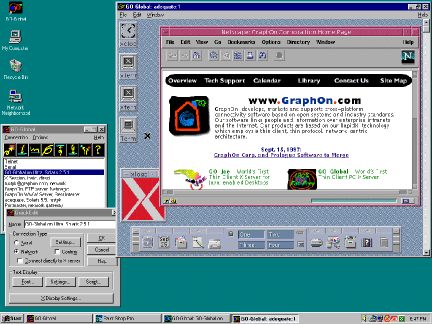Solaris to get GraphOn X server
JavaStations to ship with sub-100 KB X client
|
|
Solaris to get GraphOn X serverJavaStations to ship with sub-100 KB X client
|
|
Mail this article to a friend |
Sun Microsystems seems taken with the idea. It is including GraphOn's Go-Joe client in its JavaStation NCs, and, according to GraphOn, Sun will integrate the GlobalHost X server into future versions of the Solaris X server.
Traditionally, X server software has sat on the client, where in client/server fashion, it has busily displayed X Window System protocol information served up from X applications. GraphOn has moved the X server from the client onto the server, where according to GraphOn it can take advantage of superior server-side performance to communicate more quickly with X applications. GlobalHost then communicates with a client by means of GraphOn's proprietary RapidX protocol.
On first pass, this solution seems to add another level of complexity to the whole X paradigm, going from a two-tiered to a three-tiered architecture, but GraphOn Vice President Zdravko Podolski says that the RapidX technology reduces both the frequency and quantity of communication between client and server enough to make up the difference. Compared to other X solutions, Podolski says, "on a high-performance network, our performance is comparable. In a high-latency or overloaded network, we are faster."
Chris Sandborn, a staff systems engineer with National Semiconductor in Santa Clara, CA, says his experience with GraphOn's products bears this out. He says that performance is not noticeably different on his corporate network, but the real difference comes when he connects to his office SuperSPARC 5 from his home PC. "From home over an ISDN," he says, "I don't have to wait for humongous downloads and uploads. It looks like I'm practically on the network."
|
|
|
|
|
RapidX versus Broadway
GraphOn has two clients that support RapidX: Go-GlobalPC, which is
optimized for PC use, and Go-Joe, which is written in Java.
According to Howard Pelling, Sun Information Resources (Sun IR's) Java architect, Sun was familiar with GraphOn's thin PC client and
thought a Java port might work well with the 3,000-odd JavaStations
he was ordered to deploy about a year ago. So what began as an
internal Sun project blossomed, a year later, into a commercial
product.
Pelling says that because RapidX is actually a reduced subset of X, it will not work with some of the more complex X applications. And, he adds, though "the performance is everything we could hope for at this time," the product would benefit from JavaSoft's upcoming Java 2D API with its more advanced on-screen graphics manipulation. "Once we have that," predicts Pelling, "the Go-Joe software will run even better."
RapidX is not the only "fast" version of the X protocol. In fact, the Open Group has a slimmed down version of X in its "Broadway" X-11 specification called X.fast. So why has Sun, with its affinity for open standards, chosen a proprietary solution over an open one here?
GraphOn's Robin Ford offers an answer. She says that with RapidX decisions on what to send and what not to send between client and server are made on the server. "In the Broadway scenario," she says, "[display information] must constantly be sent up and down the wire" in order for the X server, which resides on the client, to decide what information is important enough to display. "The X.fast model puts an X server on the desktop and a pseudo-server on the host," she says. "The problem is that it is still X and still very verbose. It still has the back-and-forth nature of the X protocol, which is horrible over modems, and it still requires the fat X server on the host."

Go-Global |
Sun was also, no doubt, tempted by the fact that GraphOn was able to produce a working X client for the JavaStation. Kathleen Griffin, an analyst with Summit Strategies, says that having a thin, Java-based X client translates to one important thing: selling JavaStations. "[Sun has] been having a hard time getting its JavaStations out to the market," she says, adding, "they've been really hampered by the fact that they're just running pure Java." Now that JavaStations can access X instead of only Java applications, Griffin predicts Sun's NC play will "lend itself to a much broader market."
According to GraphOn, the GoHost server will be available through SunSoft within two months and will make it into the Solaris CD sometime after the next release, which is expected in the second quarter of 1998. In the meantime, it can be obtained on GraphOn's Web site. It comes in Solaris 2.4 and 2.5 versions as well as SunOS 4.1.3, HP-UX, IBM AIX, and SCO Open Server flavors. Pricing for the Go-Global client/server package begins at $295 per seat. The Go-GlobalPC client is currently available on GraphOn's site, and the Go-Joe Java client is expected imminently.
Go-Joe has a 100 K footprint, while Go-GlobalPC takes up about 300
K and requires 4 MB of memory.
![]()
|
|
Resources
If you have technical problems with this magazine, contact webmaster@sunworld.com
URL: http://www.sunworld.com/swol-10-1997/swol-10-graphon.html
Last modified: